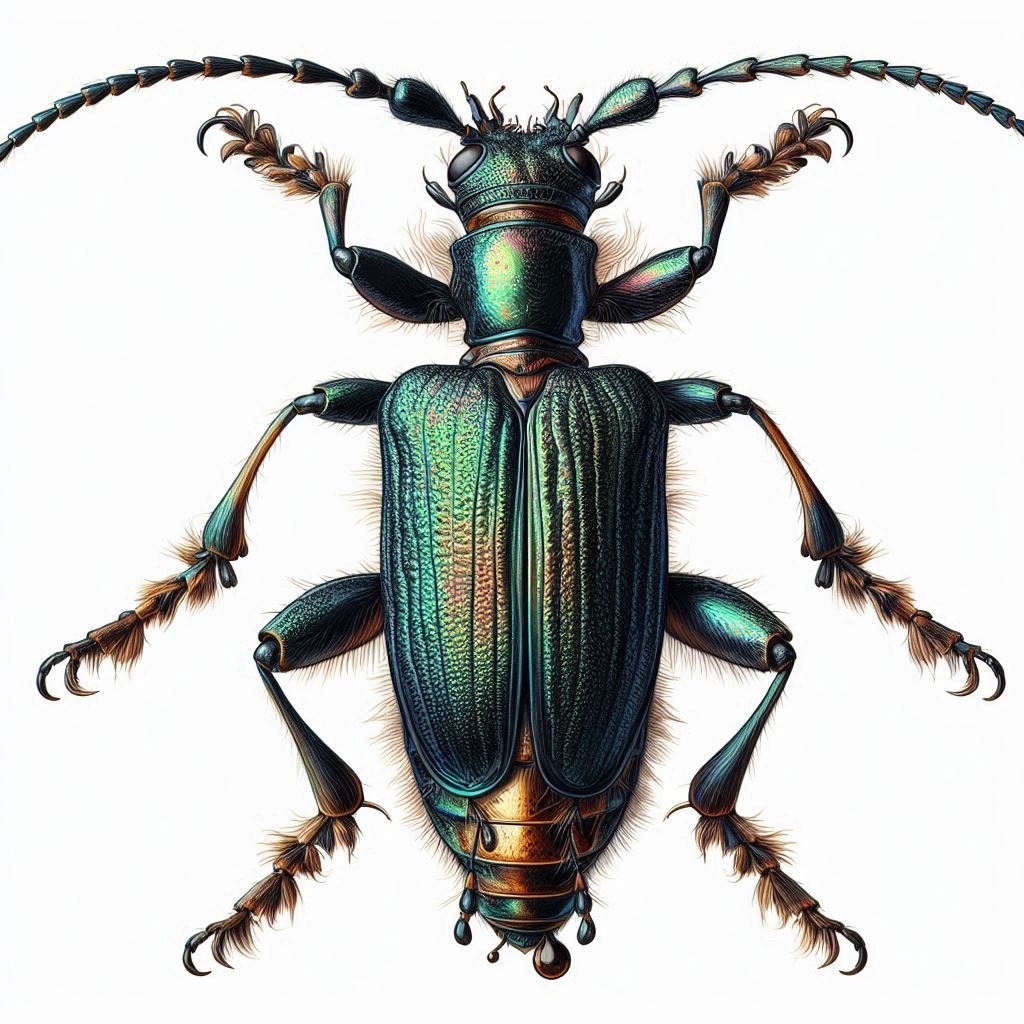Bombardier Beetle:
The bombardier beetle is a fascinating insect known for its unique defense mechanism. There are several species of bombardier beetles, but they all share this extraordinary ability to produce and eject a hot, noxious chemical spray when threatened.
Here’s how it works: The bombardier beetle has two separate glands in its abdomen that contain different chemicals, usually hydrogen peroxide and hydroquinone. When the beetle feels threatened, it mixes these chemicals together in a special chamber, where enzymes catalyze the reaction, producing a hot and toxic spray. This spray can reach temperatures of nearly 100 degrees Celsius (212 degrees Fahrenheit) and is expelled with a popping sound, which is where the name “bombardier” comes from.
This chemical spray serves as a potent deterrent against predators, such as ants, spiders, and birds, effectively discouraging them from attacking or eating the beetle. The precise mechanism of how the beetle avoids harming itself with the spray is still a subject of study and debate among scientists.
The bombardier beetle’s defense mechanism is an excellent example of nature’s ingenuity and adaptation. It’s a remarkable adaptation that has helped these beetles survive and thrive in various ecosystems around the world for millions of years.



Bombardier Beetle:
The bombardier beetle, like most beetles, has a typical insect body structure, consisting of three main segments: the head, thorax, and abdomen.
- Head: The head of the bombardier beetle contains its sensory organs, including its antennae, which are used for detecting chemicals and other stimuli in the environment. It also houses its mouthparts, including mandibles for chewing food.
- Thorax: The thorax is the middle segment of the beetle’s body and is divided into three sub-segments: the prothorax, mesothorax, and metathorax. Each segment bears a pair of legs, making a total of six legs. Additionally, the forewings, called elytra, are attached to the mesothorax and metathorax. These hardened forewings serve as protective covers for the hindwings and abdomen.
- Abdomen: The abdomen of the bombardier beetle is where its unique defense mechanism is located. It contains specialized glands that produce and store the chemicals used in its defensive spray. The abdomen also houses the beetle’s digestive and reproductive organs.
Overall, the bombardier beetle’s body structure is well-adapted for its lifestyle, including its ability to produce chemical defenses and its role as a scavenger or predator in its ecosystem.

Bombardier Beetle:
In terms of character traits, we can anthropomorphize the bombardier beetle to some extent to describe its behaviors and adaptations:
- Resourcefulness: The bombardier beetle demonstrates resourcefulness by utilizing its unique defense mechanism to deter predators. It has evolved to efficiently produce and deploy a chemical spray that serves as a potent deterrent against potential threats.
- Adaptability: These beetles are adaptable creatures, capable of thriving in various habitats around the world. Their ability to adjust to different environmental conditions and find suitable food sources contributes to their survival.
- Defensive: One of the most prominent character traits of the bombardier beetle is its defensive nature. When threatened, it doesn’t hesitate to activate its chemical defense mechanism, even at the risk of its own safety. This demonstrates a strong instinct for self-preservation.
- Survival Instinct: The bombardier beetle’s behavior highlights its strong survival instinct. It has evolved over millions of years to develop effective strategies for avoiding predation and ensuring its continued existence in its ecosystem.
- Persistence: Despite being relatively small creatures, bombardier beetles can be quite persistent in defending themselves against predators. They will continue to discharge their chemical spray and evade threats until the danger has passed.
- Curiosity (to a limited extent): While not traditionally considered a character trait, some behaviors of bombardier beetles might suggest a certain level of curiosity or exploration. Like many insects, they may investigate their surroundings for potential food sources or suitable habitats.
These character traits collectively contribute to the bombardier beetle’s success as a species, allowing it to effectively navigate its environment and fulfill its ecological role.

Bombardier Beetle:
Bombardier beetles have evolved several adaptations to survive in their environment, which typically includes various terrestrial habitats such as forests, grasslands, and deserts. Here’s how they manage to thrive:
- Chemical Defense Mechanism: The most notable adaptation of bombardier beetles is their ability to produce and discharge a hot, noxious chemical spray when threatened. This defense mechanism helps deter predators such as ants, spiders, and birds, allowing the beetles to escape unharmed.
- Camouflage: Like many beetles, bombardier beetles often have coloration or patterns that help them blend into their surroundings, providing camouflage and making it harder for predators to detect them.
- Efficient Foraging: Bombardier beetles are opportunistic feeders, scavenging on a wide variety of organic matter including dead insects, decaying plant material, and even other beetles. Their ability to locate and consume food efficiently contributes to their survival.
- Adaptability: These beetles are adaptable to different environmental conditions and can be found in a range of habitats worldwide. They are not limited to specific ecosystems and can adjust their behavior and physiology to suit their surroundings.
- Burrowing and Sheltering: Some species of bombardier beetles may burrow into the soil or seek shelter under rocks or debris during adverse conditions, providing protection from predators and environmental stressors.
- Life Cycle Strategies: Bombardier beetles typically undergo complete metamorphosis, with distinct larval and pupal stages before emerging as adults. This life cycle allows them to exploit different niches within their environment and reduces competition between life stages.
- Chemical Communication: In addition to their defensive spray, bombardier beetles may use chemical signals for communication within their species, such as marking territories or attracting mates.
Overall, the combination of their chemical defense mechanism, foraging behavior, adaptability, and other adaptations allows bombardier beetles to effectively survive and thrive in a wide range of environments despite the presence of potential predators and other challenges.

Bombardier Beetle:
Bombardier beetles play several roles in maintaining the balance of nature and contributing to the health of ecosystems:
- Prey Control: By feeding on a variety of organic matter including dead insects, decaying plant material, and other beetles, bombardier beetles help control populations of potential pests. This can prevent outbreaks of harmful insects and maintain the balance of prey and predator populations within ecosystems.
- Nutrient Cycling: As scavengers, bombardier beetles play a vital role in nutrient cycling within ecosystems. By breaking down organic matter and returning nutrients to the soil, they contribute to the health of plant communities and support the growth of vegetation.
- Indicator Species: The presence and abundance of bombardier beetles can serve as indicators of ecosystem health. Changes in their populations or distributions may reflect broader ecological changes, such as habitat loss, pollution, or climate change, providing valuable insights for conservation efforts.
- Biodiversity Support: Bombardier beetles are part of the diverse array of species that inhabit ecosystems worldwide. By contributing to the overall biodiversity of their habitats, they help ensure the resilience and stability of ecosystems in the face of environmental disturbances.
- Research and Inspiration: The unique chemical defense mechanism of bombardier beetles has attracted scientific interest and inspired research in fields such as biochemistry and materials science. Studying the beetles’ ability to produce and deploy hot, noxious chemicals could lead to new insights into chemical synthesis, defense strategies, and biomimetic technologies.
While bombardier beetles may seem small in the grand scheme of things, their contributions to ecosystem functioning and their fascinating adaptations highlight the interconnectedness of species and the importance of biodiversity conservation for maintaining the balance of nature.

Bombardier Beetle:
The scientific name of the bombardier beetle varies depending on the species. However, the most well-known genus of bombardier beetles is Brachinus. Some other genera include Pheropsophus and Stenaptinus. These beetles belong to the family Carabidae, which is a large family of ground beetles.
The scientific life cycle of bombardier beetles generally follows a typical insect life cycle with four stages: egg, larva, pupa, and adult. The adult female beetle lays eggs in the soil or other suitable locations. The eggs hatch into larvae, which undergo several molts as they grow and develop. Eventually, the larvae pupate, undergoing metamorphosis inside a cocoon or pupal case. After completing the pupal stage, adult beetles emerge and begin their reproductive phase, continuing the cycle. The exact duration of each life stage and the number of generations per year can vary among species and environmental conditions.

Bombardier Beetle:
Bombardier beetles release a hot, noxious chemical spray when they are in danger as a defense mechanism to deter predators. This spray serves as a highly effective means of protection against potential threats. Here’s how it works:
- Chemical Reaction: Bombardier beetles have specialized glands in their abdomen that contain two separate chemicals: hydrogen peroxide and hydroquinone. When the beetle feels threatened, it mixes these chemicals together in a special chamber within its abdomen.
- Enzymatic Reaction: Inside the beetle’s abdomen, enzymes catalyze the reaction between hydrogen peroxide and hydroquinone, resulting in the rapid production of benzoquinone and steam. This reaction is highly exothermic, meaning it releases a significant amount of heat.
- Expulsion: The intense heat generated by the chemical reaction causes the mixture to vaporize, creating a hot, pressurized gas within the beetle’s abdomen. The beetle then forcefully expels this gas through a specialized valve, directing it toward the perceived threat.
- Effectiveness: The hot, noxious spray produced by bombardier beetles is extremely irritating to predators such as ants, spiders, and birds. It can cause pain, irritation, and even temporary blindness, effectively deterring attackers and allowing the beetle to escape unharmed.
In summary, bombardier beetles release gas when they are in danger as a defensive mechanism to ward off predators. This chemical defense system has evolved over millions of years and is highly effective at protecting the beetles from harm in their natural environment.

Bombardier Beetle:
Bombardier beetles and humans are vastly different organisms, but there are some interesting differences and similarities between them:
Differences:
- Size and Complexity: Bombardier beetles are small insects, typically ranging from a few millimeters to around a centimeter in length, whereas humans are large, complex mammals. Humans have significantly more cells, organs, and bodily systems compared to bombardier beetles.
- Anatomy and Physiology: Bombardier beetles have an exoskeleton, segmented body, and specialized glands for producing chemical defenses. Humans have an endoskeleton, with internal organs and systems responsible for various functions such as respiration, digestion, and circulation.
- Behavior and Communication: Bombardier beetles primarily rely on instinctual behaviors and chemical signals for communication within their species. Humans have highly developed brains that allow for complex cognitive abilities, language, and social interactions.
- Reproduction and Development: Bombardier beetles undergo complete metamorphosis, with distinct larval and pupal stages before emerging as adults. Humans have a different reproductive process involving internal fertilization, gestation, and live birth.
Similarities:
- Survival Instinct: Both bombardier beetles and humans possess a strong instinct for self-preservation. They exhibit behaviors and adaptations aimed at avoiding danger and ensuring their continued survival.
- Adaptability: Both species are capable of adapting to a wide range of environmental conditions and habitats. Bombardier beetles can be found in various terrestrial ecosystems, while humans have inhabited diverse environments across the globe.
- Social Structure: While bombardier beetles are not social insects like ants or bees, they may exhibit certain social behaviors such as territoriality or mating rituals within their species. Humans, of course, have highly complex social structures and cultural practices that facilitate cooperation and group living.
- Ecological Interactions: Both bombardier beetles and humans interact with other organisms and play roles in their respective ecosystems. Bombardier beetles contribute to nutrient cycling and prey control, while humans have significant impacts on ecosystems through activities such as agriculture, urbanization, and resource exploitation.
While bombardier beetles and humans are vastly different in many aspects, it’s interesting to consider the similarities and differences between these two species from a biological and ecological perspective.
Read More Interesting Story:
https://dotparks.com/football-game/
https://dotparks.com/transformers/
https://dotparks.com/ludo-game/
https://dotparks.com/capacitor/
https://dotparks.com/what-is-transistor/
https://dotparks.com/zener-diode-in-mobile-motherboard/
https://dotparks.com/ants-community/

